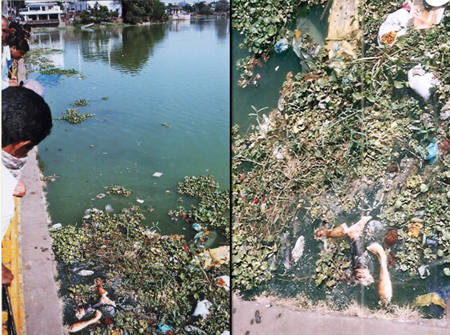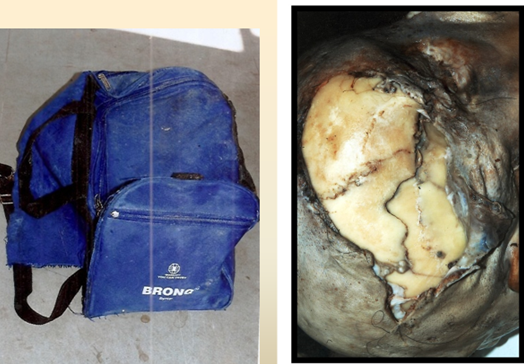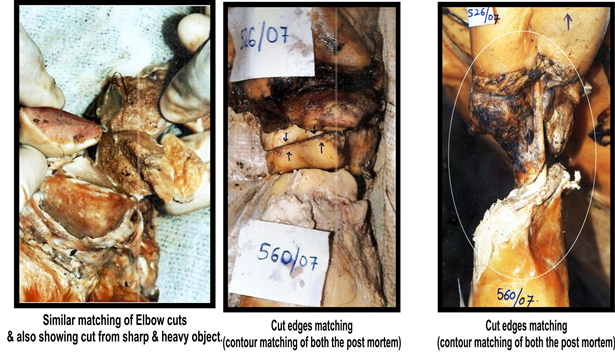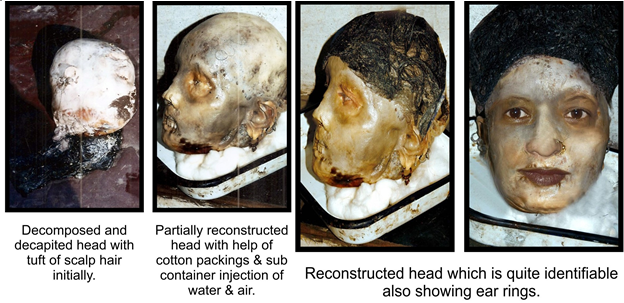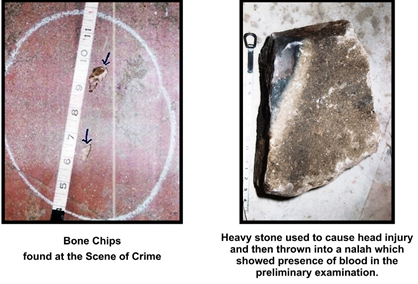Introduction
Crime scene investigation entirely depends on the physical evidences which found on the scene of incidence.1, 2, 3, 4 But in some cases, two different locations in a single crime, the crime and scene of incidence were different as crime committed at one location called primary or actual scene of crime and the body or the body parts disposed off in different locations called secondary scene of crime.5, 6 Identification of dead body is one of the most common but complicated activities especially in the cases of decomposed bodies. Analysis of the collected physical evidences from crime scene can connect two different locations of a crime scene and lead to success in solving the criminal investigation.7 The mutilated, decomposed and unknown dead body sometimes lead to the identification on the basis of clothing, footwear, his/her belongings and other objects found on the surroundings of the body with forensic expertise.8, 9 However, physical evidences did not always lead to a clear interpretation of the cause of death.10
Case History
A mutilated body of a female victim was found at a place called, Kalajhora Pulia, Police station Sultanpur, Distt. Raisen about 70km from Bhopal, Madhya Pradesh (Figure 1).
Figure 2
Both the fore limbs & fore arm sharplt amputated and showing adiposis changes indicating found in water, right leg also having salwar
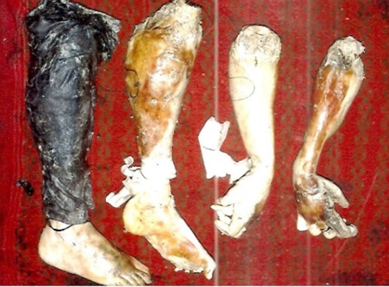
Postmortem was performed at Medicolegal Institute, Bhopal.
Observations
The body was found in a decomposing state.
Head, both hands beyond elbow and both the lower limbs were found to be severed from the body and were missing; only the trunk was present (Figure 2).
Dismemberment was observed to be done with a heavy and sharp cutting object.
Age of the victim was established to be in the range of 30-35years.
Body was also observed to be having linea albicantes indicating previous pregnancy.
Death was estimated to be about 5 to 10 days earlier.
Body also had burn effects, postmortem in nature, indicating failed attempts to destroy evidences.
Viscera of bone marrow and also of vaginal swab were preserved for laboratory examinations and DNA test and also to ascertain the possibility of sexual violence.
The forensic expert investigating the case to plan further steps meticulously to unravel the case. The investigating officers were made quite aware of the possibility of finding the missing body parts in the near future and a proper reconstruction of the case may be required, so the body was preserved.
Incidentally after about 4 days the other missing body parts were found in a small travel bag found floating in the lower lake of Bhopal (Figure 3) P.M examination of the recovered body parts were done and the following points were observed.
Remains were in advanced stage of decomposition.
Scalp hair was found separated; five cervical vertebrae were attached to the skull.
Yellow metallic nose ring in the left ala of nose.
Left external ear lobule and helix were having five rings, four in helix and one in the lobule. It was same in the right ear as well.
The teeth from both the jaws had erupted with good attrition effect.
Both the forearms were found amputated from the elbows. Both the lower limbs were also amputated from the knee joints.
The bag which contained the remains of the body was of a blue color nylon material and had the imprint of the logo of Bronx, a common cough syrup Since normally the bag was given by a pharmaceutical company to the medical practitioners, it indicated a connection of the case to someone which may be related to medical field. On thorough examination of the bag, a wet folded paper containing the resume of one person, aged about 27 years, son of a medical practitioner, which obviously had escaped the notice of three possible offender.
The bag also contained green and orange colored nylon packing rope, a small L-shaped iron rod and a small knife with orange colored handle.
The skull was found to have a lacerated wound on the right parietal region with a depressed fracture in the bone (Figure 3). Left parietal area also had 7 cm long wound with periosteal ecchymosis, 2 pieces of the transverse process of the 5th cervical vertebra with sharp cut was also found. These ante-mortem injuries to the head were sufficient to cause death according to the forensic expert’s opinion and were homicidal in nature.
Separation of limbs with multiple inflictions was postmortem in nature and was caused by a sharp, heavy object (Figure 4).
Elapsed duration of death was estimated to be approx. 1 week to 10 days from the date of recovery of the body remains. Foot length was 8 inches and approx. height of the victim was 5 feet.
Crime scene reconstruction
After reconstruction from above mentioned information, it was concluded that
Since the recovered bag which is usually distributed by a pharmaceutical company and the resume sheet recovered therein indicated to a person connected to the crime, provided strong direction to the case and was made easy to identify the owner of the bag.
The head was severely decomposed and all the features were masked. But with some efforts the collapse of the nose, eyes and lips were reconstructed and given shape with the help of inserted cotton swabs and injecting water and air into the subcutaneous space of the skin. The collapsed eyes were given pressure from inside to make them project out. All available scalp hairs were put over the scalp and rearranged as much as possible and the photographs as needed were taken. From these efforts it was possible to rebuild the face enough to be identified by the friends and neighbors of the victim (Figure 5).
All the recovered remains including the clothes were matched with the body (trunk) which was recovered earlier on 08.04.07 and were found to be of same individual. After this reconstruction the suspect was identified with the help of the resume found in the bag, and was interrogated. The scene of crime was identified which was the residence of the suspect in Bhopal. We were able to trace more evidence like the object that caused the fatal head injury, a stone and blood spots and bony chips created during the mutilation of the body were all recovered from the spot.
The bone chips were later identified as human long bone joints of 30-35 years. The blood recovered from the crime spot was established to be of same individual. i.e., the victim. All these careful and detailed reconstruction provided the breakthrough needed to solve the case to a satisfactory conclusion.
The body was identified as that of a woman, Roshan aged about 35 years, R/O Mount Abu, Rajasthan. As the recovered skull was promptly reconstructed with great efforts and the face was made recognizable and was identified by the neighbors and friends. The story as it emerged from this case is that the son of a medical practitioner R/O Sultanpur, Distt. Raisen, who was living illegal co-habitation with the deceased, Roshan who had left her husband and children. She was already married and a mother of two children. Our indication in post-mortem the presence of linea albicantes confirmed our earlier observations. During this period the parents of the accused had fixed his marriage with a final year medical student and also the deceased had been pressing the accused to marry her. The accused then decide to get rid off and finally decide to kill this woman so that he could marry the medical student as desired by his parents.
One day, the accused brought a big piece of stone and struck the victim while she was sleeping on the head resulting in her death. Then, he dismembered the body with the help of slaughtering knife (which confirmed our own opinion that mutilation of the body was done with sharp heavy object) so, that he could dispose the body parts in the different places in order that the identity of the victim may not be established or so as was the belief of the culprit.
Conclusion
Serological examinations and DNA test also confirmed the findings subsequently. This case is a very fine example of primary and secondary location of crime scene and how available minor clues can be put together and a thorough scientific investigation leading to a proper reconstruction of the events in this case and hence the case was solved to the satisfaction of all concerned.


